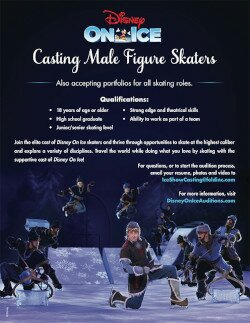
For four years, they skated in the shadow of one of the most accomplished pairs teams in Canadian figure skating history.
But now, their moment is at hand. The mantle has been passed and it is the time for Kirsten Moore-Towers and Michael Marinaro to lead the way for a new generation of pairs teams in their homeland. Both feel more than ready to take on the task.
The pairs landscape in Canada has surely changed since the 2018 national championships. Kirsten Moore-Towers and Michael Marinaro head into this new season as the top pairs team in their country and the only team remaining of the four that battled it out for the three places at the Olympic Winter Games in PyeongChang. Not only are Meagan Duhamel and Eric Radford gone, but Julianne Séguin and Charlie Bilodeau — the silver medalists at 2018 nationals — ended their partnership in July. Dylan Moscovitch and Liubov Ilyushechkina, fourth at nationals, ended their collaboration in March.
“It’s bizarre,” Moore-Towers, 26, said of heading into a season that does not include any of those teams. “Neither of us have ever really felt this before … in my whole career, Meagan and Eric have always been there. I’ve always been fighting to be that team, but now we have faith that we can lead the charge and do a similar thing. We want to win nationals next January, and we’d also like to promote and help pairs skating grow in Canada, so we have a strong team again four years from now. It is definitely our intention to lead the charge.”
The partnership of Moore-Towers and Marinaro was born after she split with Moscovitch in 2014. Moore-Towers said she was naïve to think it would come together quickly. “The beginning years of our partnership were very difficult for a number of reasons. We weren’t jelling as we wanted to or as much as people thought we should.
“We wanted to be our own team, and we weren’t quite sure how to do that with the coaching team Dylan and I had. It was difficult to branch out from what I was used to, with everything the same around me. We made the move to Montréal to take steps in that direction.”
CHANGING OF THE GUARD
Four years later, the door is now wide open for the duo to ascend the pairs throne in Canada. But they do not want to stop there. “Nationals is a really big goal for us,” said Moore-Towers. “We’d also like to make a bigger name for ourselves in the world.
“We know that in order to do that, we need to be stronger in the short program. Last year, we were always relying on our long to bring us up a few places, so we believe if we can come out with a stronger short, then we can make a bigger name for ourselves. We’re shooting to be among that top group in the world, and we’d like to skate in the last group (at Worlds).”
The team claimed their first Grand Prix medal last season — bronze at Cup of China — and emerged from a heated duel at nationals with a third-place finish and a prized berth on the Olympic team. Making that squad was far from a sure thing. Four teams were in the hunt for the three places available at the Olympic Games, with Duhamel and Radford a virtual lock for one of them.
Moore-Towers and Marinaro followed up an 11th–place finish in PyeongChang with a sixth-place finish at the World Championships in Milan, Italy. “Definitely, last season was a dream come true for us,” said Marinaro, 26. “We knew we had to start the process of qualifying for the Games in August last year, so that off-season was vastly different than it has been this season.
“It was the moment I have been thinking about for at least 15 years,” Marinaro said of making the Olympic team. “It was pretty special to have both my parents there. They don’t make it out to too many of my competitions, so to have them in the stands and then see them in the moment right after qualifying for the team …it was very, very special. There was a lot of family sacrifice over the years leading up to that, so it was definitely a very special moment for the whole family.”
Though it was her second time qualifying for an Olympic team, Moore-Towers said, “this one felt so much sweeter,” in part because the road to get there was so much tougher. “Dylan and I set ourselves up better in the years prior to 2014,” she said in reference to her previous partnership. “Mike and I tried as hard as we could, but we didn’t do that as well. So, we knew it would all come down to nationals, and that was a pressure I hadn’t really dealt with before.”
Moore-Towers went into the Games as the Olympic “veteran” of the duo, and she was impressed at how well Marinaro handled it. “Everyone always asks him if he looked to me for guidance on things that maybe I had experienced and he hadn’t,” she said. “But our partnership has never really been like that. There’s a lot of give and take, and he balances me and takes my stress away as much if not more than the opposite.”
Marinaro said the Olympic experience fueled his desire to do it all again in four years’ time in Beijing. “It was 10 times more exciting than I ever thought it was going to be. I thought I was motivated before going to the Games, but now, after experiencing it and tasting it, I’m on a whole new level and ready to get back there and do big things, hopefully.”
WORLDLY STRESS
Moore-Towers and Marinaro did a “big thing” for Canada at the ensuing Worlds in Milan. When two of the three Canadian teams did not qualify for the free skate, Moore-Towers and Marinaro had to finish 10th or better to assure the country two spots at 2019 Worlds. They were sitting right on that line after the short program.
Complicating matters was the fact Moore-Towers suffered an ankle injury during the Olympics, and it had not healed by the time they arrived in Italy. “We didn’t train at all when we got home from the PyeongChang,” she said. “We tried to skate around a little bit, and do lifts and some elements that I was able to do. But my ankle hurt so badly in my skate — we were so limited. The short program at Worlds was the first we had done since our long program at the Olympics. So, it was really a mental test for us.”
Skate Canada high-performance director Michael Slipchuk tried to take the heat off them heading into the long program, telling the duo to “just have fun and do the best you can,” which Moore-Towers said “helped take the stress off a little bit. I personally appreciated hearing that.”
But there was no escaping the magnitude of the task that had been placed in front of them. “Our coaches (Richard Gauthier, Bruno Marcotte and Sylvie Fullum) were stressed and we could feel it,” Moore-Towers said.
“I told Mike, ‘I don’t know if I’ll make it to the end, so if I need to stop for a second, bear with me and we’ll keep going.’ Nobody really knew how it would end up. We were not able to warm up throws because of the pain in my ankle, so the first throw would be in the program. We didn’t know how it was going to go, to do two throws in five minutes. It was insane.”
But the duo came through, delivering a personal-best long program, and rising to sixth in the final standings. “It was amazing. We knew we had tobe10th,” said Moore-Towers. “It was a cool day for us all the way around. We were super happy.”
For Marinaro, the achievement was “a testament to the season and all the work we put in all year. That gave us something to fall back on. It was definitely a unique situation for me. I’ve never been in the position of competing for anything other than myself. It was a high-pressure situation, and we felt it. But we dealt with it really well.”
Moore-Towers said their “trials and tribulations are what have strengthened us as a team the most. We learn so much more from our difficult times and Mike and I have had a few. Through each one, our communication gets a little bit better and our partnership gets a little bit stronger, and our perspective improves.
“When we start having a broader picture of what our career will look like, we grow. Mike is a little better at seeing that than me, and he’s always reminding me that we are on our way.”
Marinaro agreed. “With all the ups and downs, it’s helped us move in the right direction. All the negative situations we’ve been able to turn into positives and learn from them. If all the negative things hadn’t happened, we wouldn’t be on the path we are now on to set up for the next four years. We have some momentum right now and we need to keep pushing.”
LINGERING INJURY
The off-season provided yet another test of their mental strength. The ailment Moore-Towers dealt with at Worlds is an overuse injury that affects the cartilage in her right ankle. It lingered and prevented the duo from training until the end of June. Even then, their work in the early part of the summer was limited.
Their new programs, both choreographed by Julie Marcotte, should take them another step in that direction. The short program is a Leona Lewis version of the Roberta Flack hit “The First Time Ever I Saw Your Face.” The long program is a medley of Pink Floyd music.
“We felt like we needed to do something different for a long, especially at the beginning of a quadrennial,” said Moore- Towers. “We wanted to expand our skating as much as we can and not be known as a team that can only do one style.”
They will present their new programs at two Grand Prix events — Skate Canada and NHK Trophy — and are hoping to reach the Final on home ice in Vancouver. Moore-Towers and Marinaro see that as a possibility. “With the Grand Prix Final happening in Canada that’s extra motivation, and we’d really love to be there,” she said. “That’s another big goal.“
RELATED CONTENT:
2019 CANADIANS FINALE





